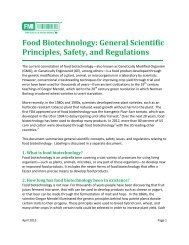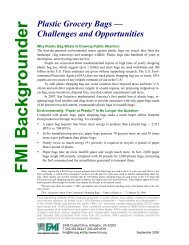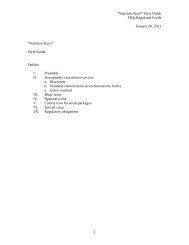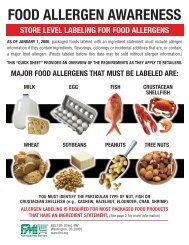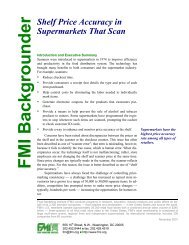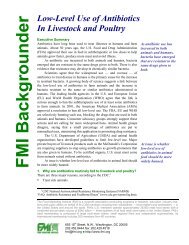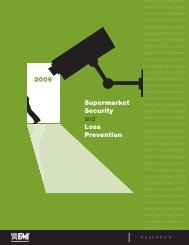Consumer Shopping Habits for Wellness and Environmentally ...
Consumer Shopping Habits for Wellness and Environmentally ...
Consumer Shopping Habits for Wellness and Environmentally ...
You also want an ePaper? Increase the reach of your titles
YUMPU automatically turns print PDFs into web optimized ePapers that Google loves.
u Some categories show serious consumer knowledge gaps. Less-experienced H+W consumers often have a hard<br />
time underst<strong>and</strong>ing what makes a more H+W-oriented version of a product different from a conventional product.<br />
There are strong opportunities <strong>for</strong> manufacturers <strong>and</strong> retailers to assist consumers here by making key attributes<br />
<strong>and</strong> differentiators clear.<br />
u Dem<strong>and</strong> <strong>for</strong> natural <strong>and</strong>/or organic products varies by category. Foods are most sensitive to this, but approximately<br />
50% of consumers say it is “important” in both cleaning <strong>and</strong> personal care products (foods range from 55-70%,<br />
general merch<strong>and</strong>ise rates approximately 30%).<br />
• Cleaning products top the list when consumers were asked about desiring “more choices in natural <strong>and</strong> organic”<br />
product options, with several personal care categories also appearing toward the top of the list. Cleaning products<br />
also top the chart by a very wide margin when consumers are asked about toxicity concerns.<br />
u Purchase decision criteria vary by product category <strong>and</strong> by H+W orientation. There are far too many different<br />
criteria to explain in this summary in a general sense (please see Chapter 3).<br />
• For less lifestyle-involved consumers (Periphery, outer Mid-level), notions of effectiveness <strong>and</strong> price generally<br />
tend to be present in purchase decisions<br />
• Notions of purity, toxicity avoidance <strong>and</strong> environmental friendliness often serve as purchase criteria <strong>for</strong> more<br />
lifestyle-involved consumers (Core, inner Mid-level)<br />
u Price concerns are most acute in the categories of vitamins <strong>and</strong> minerals, OTC, <strong>and</strong> organic <strong>and</strong> natural foods. Price<br />
concerns <strong>for</strong> cleaning products are “all over the map,” with laundry detergent having the highest concern rating of<br />
all product types, but many other products not holding nearly the same level of concern.<br />
• Price declines as a concern as consumers evolve in their H+W. Many lifestyle-committed Mid-level <strong>and</strong> Core<br />
consumers tend to care more about specific product attributes (e.g., organic) than price.<br />
u Product packaging <strong>and</strong> labeling is highly relevant to H+W <strong>and</strong> sustainability impressions.<br />
• Basic packaging <strong>for</strong>mat provides important sustainability indicators (e.g., recyclable, made from recycled materials<br />
<strong>and</strong> biodegradable) to consumers.<br />
• Many H+W products in study categories are unattractive <strong>and</strong>/or unclear to consumers. Elegant, contemporary<br />
packaging <strong>and</strong> clear labeling (product purpose, <strong>and</strong> key attributes) are often critical <strong>for</strong> a product to enter into a<br />
shopper‘s consideration set at shelf, especially with new, “trying it <strong>for</strong> the first time” H+W SKUs.<br />
u Recyclability tops the list of sustainable product attributes <strong>for</strong> consumers, <strong>for</strong> all segments.<br />
Retail Findings<br />
u Channel use varies by H+W orientation.<br />
• Periphery consumers tend toward the use of mainstream (e.g., drug, mass, club <strong>and</strong> grocery) channels in<br />
most categories.<br />
• Mid-level consumers use mainstream channels <strong>for</strong> most of their shopping, but also make fairly frequent use of<br />
specialty (specialty, grocery, <strong>and</strong> where available, specialty drug) channels.<br />
• Core consumers do use mainstream channels in some categories, but tend to use specialty channels when they<br />
are available in their areas.<br />
u <strong>Consumer</strong>s’ channel choices tend to change as they evolve as H+W consumers – retailers can retain those evolving<br />
consumers through developing specific H+W categories that vary to some degree by channel (see Chapter 4 <strong>for</strong><br />
detailed strategies by channel).<br />
u <strong>Consumer</strong>s tend to shop across many channels, having specific channel preferences <strong>for</strong> different categories.<br />
• Grocery is a preferred channel <strong>for</strong> functional beverages, as well as being a “solid option” across several home<br />
cleaning <strong>and</strong> personal care categories (of course, it is also strongly preferred <strong>for</strong> most food purchases, though<br />
that category was not tested in this research).<br />
The Association <strong>for</strong> GM <strong>and</strong> HBW<br />
Connectivity, Education, <strong>and</strong> Research<br />
<strong>Consumer</strong> <strong>Shopping</strong> <strong>Habits</strong> Study




